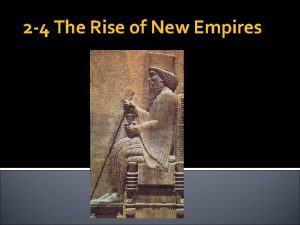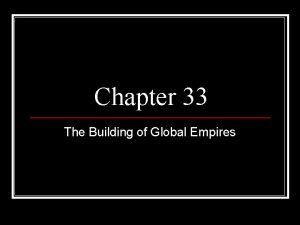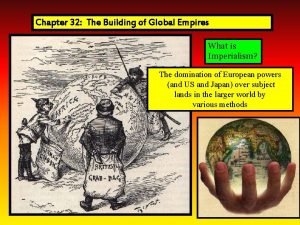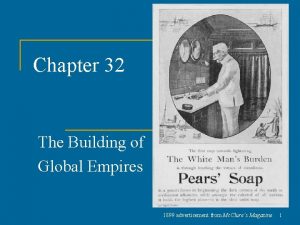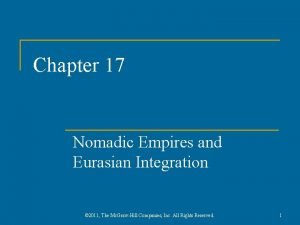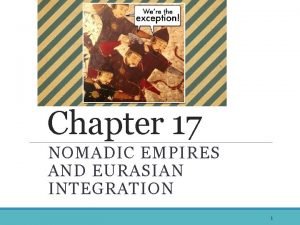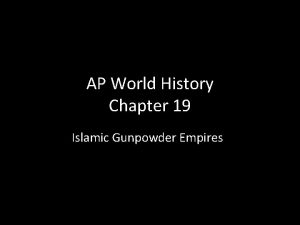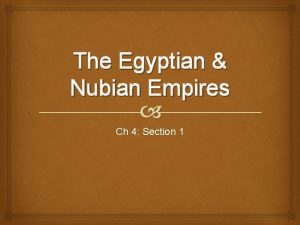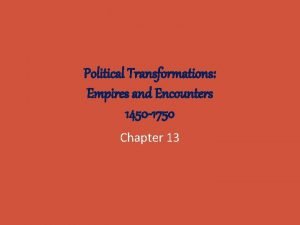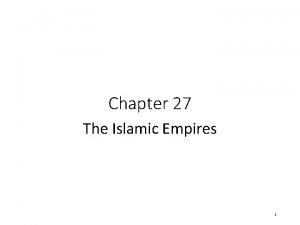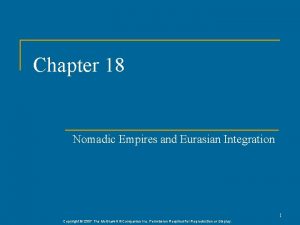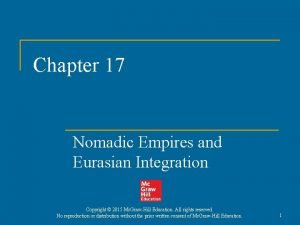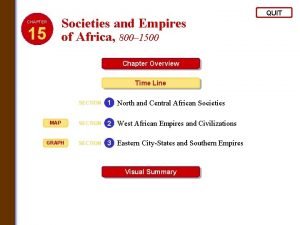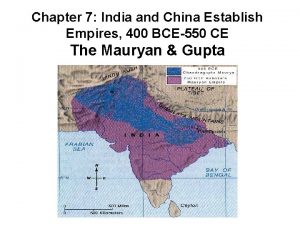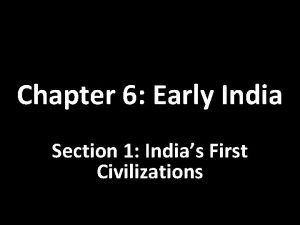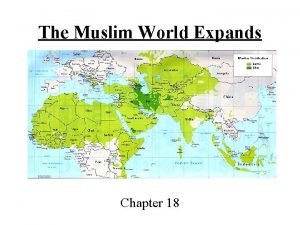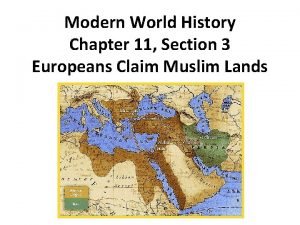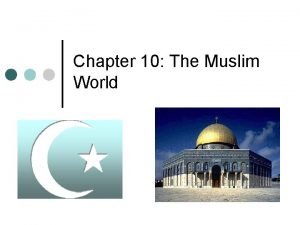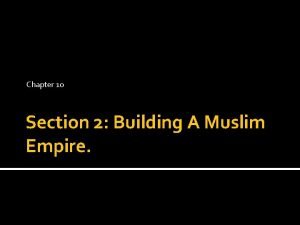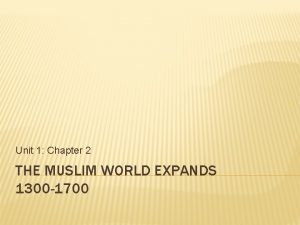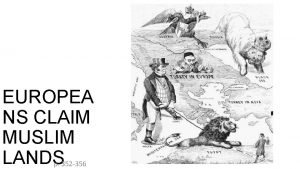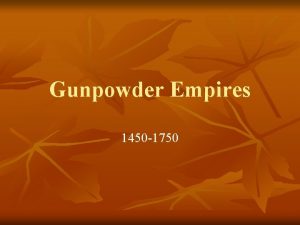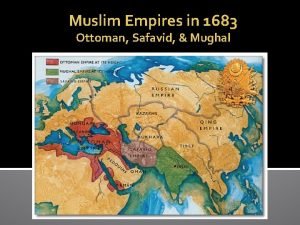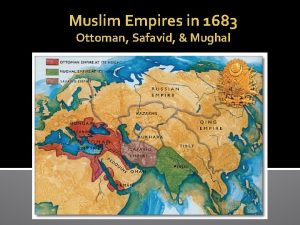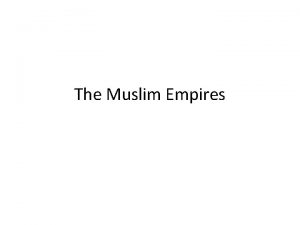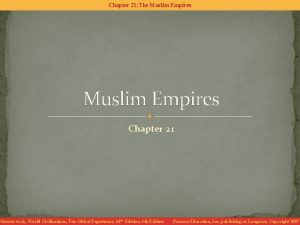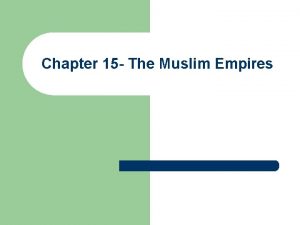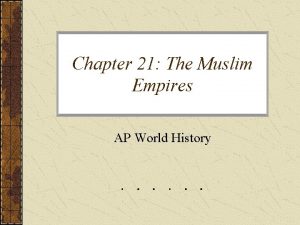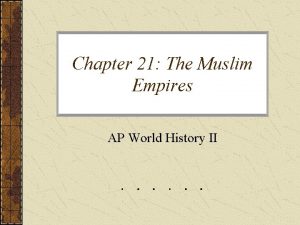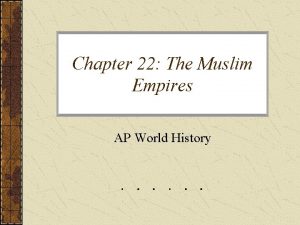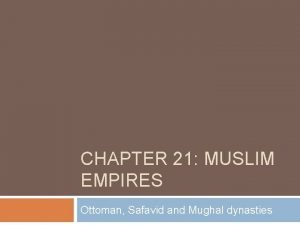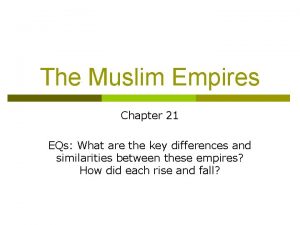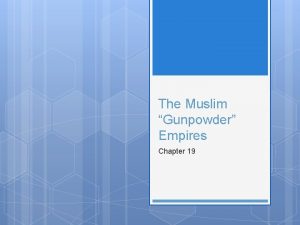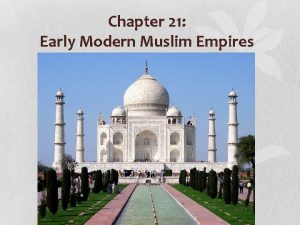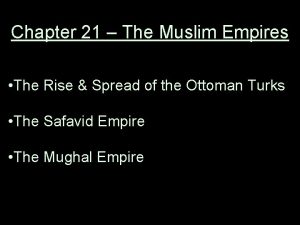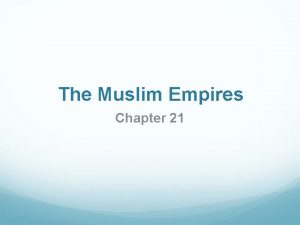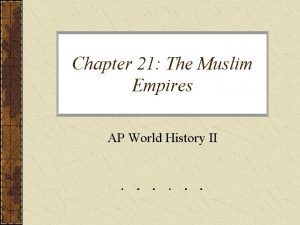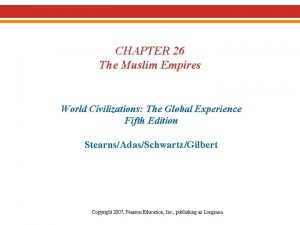Chapter 21 The Muslim Empires 3 New Muslim





































- Slides: 37

Chapter 21: The Muslim Empires

3 New Muslim Empires • 13 th c. Mongol invasions destroyed Muslim (Abbasid) unity • The Gunpowder Empires: New Muslim empires emerge to bring a new growth of Islamic civilization 1. Ottomans (1299 -1923, Sunni) 2. Safavids (1501 -1736, Shi’a) 3. Mughals(1528 -1857, Sunni) *Remember Shi’a believe blood successor* • Similarities • Great military and political powers; effective use of gunpowder • Islamic Renaissance • Spread of Islam to new territories; religious zeal • Originate from Turkish nomadic cultures • Ruled by absolute monarchs • Tax agrarian populations • Differences • Mughals: rule mostly non-Muslims (Hindus in India) • Safavids: rule mostly Muslims (Shi’a) • Ottomans: rule mixture of Muslims (Sunni) and Christians

3 New Muslim Empires

Story Time p. 236 “The Ottoman’s” • Take Notes on The Ottomans: • • • - • Do you want to take notes before we lecture on Ottoman’s or after? ? ?

The Ottoman Rise • 1243 CE: Seljuk Turks fell to the Mongols. • 1350 s: Sunni Ottomans were driven to expand began building an empire based in Anatolia (Asia Minor), Turkey. • Named after Osman Bey, leader • Rapidly expand territory into Balkans • 1453: Mehmed II leads the Ottomans to conquer Constantinople with 100, 000 soldiers. • Extended empire into Syria, Egypt, north Africa, Hungary, Black and Red Seas. • Powerful army: build up firearms, cannons • Threat to Western Europe: 16 th/17 th c. sieges on Vienna, Austria • Powerful navy throughout Mediterranean until defeat at Battle of Lepanto in 1571

Height of Ottoman Empire

Ottoman Military: Janissaries • Ottomans are focused on warfare; desire to create a class of warriors that are loyal to Sultan only • Janissaries were captured conscripted Christian boys that made up the bulk of the Ottoman infantry • Legal slaves • Highly educated and placed with Ottoman families to be converted to Islam • Janissaries controlled the artillery and firearms so they were the most powerful component of the military. • Ultimately, will block much needed reform as empire begins to decline • Eventually tried to translate military service into political influence.

Ottoman Sultans and Their Court • Absolute monarchs (sultans) who were skilled at controlling different religious and legal factions. • Ottoman conquest often meant effective administration and tax relief for areas annexed to the empire. • As the empire grew, sultans lost contact with their subjects. • Administration was carried out by a grand vizier and bureaucracy. • Islamic principles of succession are problematic. • Vague and often contested

The Flourishing of Ottoman Culture • Ottomans restored capital of Constantinople. • Each Sultan tried to beautify the capital. • Sultans and administrators built mansion, religious schools, hospitals, rest houses, gardens. • Hagia Sophia was converted into a mosque. • Commercial center: great bazaars • Merchant and artisan classes • Turkish, then Persian, Arabic

Ottoman Society and Gender • Socially dominated by warrior aristocracies who originated as Turkish horsemen. • Ottoman sultans promoted public works projects, the arts, and promoted trade. • Ottoman women faced legal and social disadvantages. • Unable to become educated or participate in politics • Elite wives and concubines exerted influences over sultans, but most women lived unenviable lives • Subordinate to husbands and fathers • Many restricted to harems

Ottoman Military: Navy • Ottoman internal military problems led them to fall behind in improvements to military. • 1571 - Battle of Lepanto • Between Spanish & Ottomans • Signals end of Ottoman naval dominance • Try to rebuild fleet a year after battle • Portuguese naval victories in Indian Ocean weaken Ottoman presence in Indian Ocean trade. • Ottomans fell behind in technology by ignoring Western technological innovations.

Ottoman Decline • Empire lasted for over 600 years (1299 -1923) during which time the Ottomans were able to fight off many rivals. • Ultimately, the empire was too large to maintain. • Unable to expand against other Muslim and Christian groups • The effectiveness of the administration diminished as the bureaucracy became corrupt. • Fell behind in trade and warfare • Did not concern themselves with developments in Europe in 17 th / 18 th centuries • Scientific Revolution • Enlightenment • Industrial Advancements • Local officials squeezed peasants for taxes and services. • Officials become corrupt • Peasant uprisings and abandonment of lands • Silver from Peru and Mexico led to inflation (destabilizing economy) • Civil strife increased

Story Time p. 236 “The Ottoman’s” • Take Notes on The Ottomans: • • • - • Do you want to take notes before we lecture on Ottoman’s or after? ? ?

Story Time p. 238 “The Safavid’s” • Take Notes on The Safavid’s: • • • - • Do you want to take notes before we lecture on Safavid’s or after? ? ?

The Shi’a Safavids • Rose from Turkic nomadic groups after Mongol invasions. • Practice Shi’a Islam • Sail al-Din, Shi’ite Sufi mystic, began a militant campaign to purify and reform Islam • Spread Shi’a Islam throughout Turkish tribes of region (Persia and Afghanistan)

Isma’il and the Battle of Chaldiran • 1501: Isma’il won territory victories and was declared shah (emperor) of Safavid Empire. • 1514: Battle of Chaldiran • Conflict with Ottoman Empire due to variants in Islam • Safavids were NOT as militarily technologically advanced as Ottomans • Ottoman victory • Isma’il became ineffective after defeat • Shi’ism was blocked from westward advancement confined to present day Iran & Southern Iraq

Politics and War Under the Safavid Shahs • 1534 CE- After civil war, Isma’il’s son Tasmaph I won the throne. • 1587 CE- Abbas I (Abbas the Great), empire reached height of its strength and prosperity • Used youths captured in Russia, educated and converted to Islam, in the army and bureaucracy • Controlled firearm use • Received training from Europeans in efforts against Ottomans

Safavid State and Religion • Abbas I wanted empire to be center for international trade and Islamic culture • Creates capital in Isfahan • Special building projects (elaborate palaces for shahs; mosques) • Originally used Turkish language but switched to Persian after Battle of Chaldiran • Mullahs (educated in Islamic theology and law) were used as mosque officials, pray leaders and bureaucrats. • Indicates move away from militant Shi’a ideology • Bulk of Iranian population was converted to Shi’ism

Society • Mostly dominated by warrior aristocracies • Shahs promoted public works projects and promoted trade • Women: • Faced legal and social disadvantages • Wives and concubines exerted influences over shahs • Most women lived unenviable lives

The Rapid Demise of the Safavid Empire • Safavids reigned from 1501 -1736. • The collapse was rapid. (after Abbas I) • Abbas I, fearing assassinations, removed all suitable heirs. • Weak grandsons followed; led to decline. • Imperial administration collapsed. • 1722: Isfahan fell to Afghani invaders. • Nadir Khan Afshar from northern Persia declared himself shah in 1736. • Unable to restore long-lasting authority. • Area became battleground for surrounding empires, and nomadic raiders

Story Time p. 238 “The Safavid’s” • Take Notes on The Safavid’s: • • • - • Do you want to take notes before we lecture on Safavid’s or after? ? ?

Story Time p. 240 “The Mughal Empire” • Take Notes on The Mughal’s: • • • -

The Mughals in India • Founded by Babur in 1528 (militaristic conquest) • Traced his lineage back to Turkic conqueror Timur the Lame • Used gunpowder and military strategies to assert power over rivals in northern India. • More interested in territorial expansion and riches than spreading of Islam. • Interested in art and war, but a poor administrative leader • Sudden death in 1530; successor is son Humayan. • Invasions in time of weakness • Humayan dies in 1556; leaves empire to Akbar. (only 13 at time of take over)

Story Time p. 240 “Akbar’s Reign” • Take notes on Akbar’s Reign: • • • -

Akbar and the Basis for a Lasting Empire • Akbar rules 1560 -1605. • Comes to throne during period of invasions. • Akbar had a vision for the empire and wanted to united all of India. • Extended the empire throughout north and central India. • Brilliant military leader • Worked with Hindus throughout India • Used warrior aristocrats to run villages in newly established bureaucracy. • Administrative talents

Akbar’s Social Reform and Cultural Change • Encouraged widow remarriage; discouraged child marriages; legally prohibited sati; special market days. • Encourages good relationships and intermarriages between Muslims and Hindus. • Respected Hindu customs • Utilize Hindus in bureaucracy • Great patron of arts • Invented a new faith: Din-i-Ilahi • Incorporates Islam and Hinduism to unify subjects • Mughal India reached its peak at the end of Akbar’s reign and was an overseas destination for traders.

Mughal Splendor • After Akbar’s death in 1605, Jahangir (16051627) and Shah Jahan (1627 -1658) reigned. • Both retained tolerance toward Hindus, kept alliances, and fought wars against enemies. • Lack of discipline and training in Mughal armies • Both great patrons of the arts. • Building of the Taj Mahal • Famous for cotton textiles and have a large market in Europe. • Little new territory added. • India was a major trading post for the world • Majority of population in poverty • India fell behind Europe in innovations and sciences.

Mughal Art and Architecture • Mughal architecture blends Persian and Hindu traditions. • Painting workshops for miniatures. • Mughal architecture: mix of traditional Indian white marble with Islamic arches and domes. • Taj Mahal: constructed by Shah Jahan as tomb for Mumtaz Mahal, his most beloved wife. • Mughals considered one of the peaks in Indian cultural production.

Mughal Mistakes • Jahangir and Shah Jahan left the administration to subordinates; thus, their wives took control of decisions. • Elsewhere, women became more secluded; reforms of Akbar die out; sati returns, unveiled women were shunned, dowry returned. • Aurangzeb, Shah Jahan’s son, came to power with two foolish goals: 1. Determined to extend Mughal control over all India. 2. Wanted to purify Indian Islam and rid it of Hinduism

Imperial Decline • By the time of his death (1707), Aurangzeb conquered most of India but drained treasury protecting borders. • Became involved in long wars and failed to complete administrative tasks and reforms. • His religious policies weakened internal alliances with Hindus. • Social progress had been abandoned and halted. • Britain and France grow increasingly interested in India as a colony. • Central government declines; India returns to local governments by 18 th c. • Sikhs became an anti-Muslim threat.

Story Time p. 242 “The Empire in Decline” • Take notes on the Empire in Decline: • • • -

PRACTICE: In order to supply its elite Janissaries and palace bureaucrats with soldiers, the Turks… a. Used feudal levies b. Relied on old Muslim nobles and aristocrats c. Forcibly conscripted young Christian boys, converted them to Islam, and trained them d. Imported trained foreigners and mercenaries e. Relied on Muslim clergy

In order to supply its elite Janissaries and palace bureaucrats with soldiers, the Turks… • C - Forcibly conscripted young Christian boys, converted them to Islam, and trained them • The practice was long used by the Turks to fill the ranks in their armies.

Akbar used the following to build a stable state in India EXCEPT: a. b. c. d. e. A well-trained, well-led military An efficient bureaucracy and administration Patronage of the arts and intellectual developments Religious toleration and reconciliation with the Hindus Promotion of foreigners, especially Europeans, to positions of power.

Akbar used the following to build a stable state in India EXCEPT: • E - Promotion of foreigners, especially Europeans, to positions of power. • Foreigners played no part in Akbar’s reforms

All of these developments weakened the rule of the Ottoman government EXCEPT a. Powerful factions within the Janissaries and court bureaucrats b. Harem politics by rival wives and their sons, who were potential heirs c. The hedonistic lifestyles of many sultans d. Corruption and graft e. The development of the office of vizier

All of these developments weakened the rule of the Ottoman government EXCEPT • E - The development of the office of vizier • All contributed to division within the state, but the viziers were not in themselves a threat.
 Maritime vs land empires
Maritime vs land empires The rise of new empires
The rise of new empires Chapter 33 the building of global empires
Chapter 33 the building of global empires Chapter 32 the building of global empires
Chapter 32 the building of global empires Chapter 32 the building of global empires
Chapter 32 the building of global empires Chapter 17 nomadic empires and eurasian integration
Chapter 17 nomadic empires and eurasian integration Chapter 17 nomadic empires and eurasian integration
Chapter 17 nomadic empires and eurasian integration Chapter 19 islamic gunpowder empires
Chapter 19 islamic gunpowder empires Chapter 4 section 1 the egyptian and nubian empires
Chapter 4 section 1 the egyptian and nubian empires Chapter 5 political transformations empires and encounters
Chapter 5 political transformations empires and encounters Chapter 27 the islamic empires
Chapter 27 the islamic empires Chapter 27 the islamic empires
Chapter 27 the islamic empires Chapter 18 nomadic empires and eurasian integration
Chapter 18 nomadic empires and eurasian integration Chapter 17 nomadic empires and eurasian integration
Chapter 17 nomadic empires and eurasian integration Chapter 16 people and empires in the americas
Chapter 16 people and empires in the americas Chapter 33 the building of global empires
Chapter 33 the building of global empires Chapter 15 societies and empires of africa
Chapter 15 societies and empires of africa Chapter 7 section 1 india's first empires
Chapter 7 section 1 india's first empires Chapter 7 india and china establish empires
Chapter 7 india and china establish empires Chapter 7 section 1 india's first empires
Chapter 7 section 1 india's first empires Chapter 16 toward a new heaven and a new earth
Chapter 16 toward a new heaven and a new earth The muslim world expands chapter 18 answer key
The muslim world expands chapter 18 answer key Chapter 27 section 3 european claim muslim lands
Chapter 27 section 3 european claim muslim lands Chapter 27 section 3 european claim muslim lands
Chapter 27 section 3 european claim muslim lands Chapter 11 section 3 european claim muslim lands
Chapter 11 section 3 european claim muslim lands Chapter 10 the muslim world
Chapter 10 the muslim world Chapter 10 section 2 building a muslim empire
Chapter 10 section 2 building a muslim empire Chapter 2 the muslim world expands
Chapter 2 the muslim world expands Chapter 27 section 3 european claim muslim lands
Chapter 27 section 3 european claim muslim lands Hát kết hợp bộ gõ cơ thể
Hát kết hợp bộ gõ cơ thể Lp html
Lp html Bổ thể
Bổ thể Tỉ lệ cơ thể trẻ em
Tỉ lệ cơ thể trẻ em Gấu đi như thế nào
Gấu đi như thế nào Thang điểm glasgow
Thang điểm glasgow Chúa yêu trần thế
Chúa yêu trần thế Môn thể thao bắt đầu bằng chữ f
Môn thể thao bắt đầu bằng chữ f Thế nào là hệ số cao nhất
Thế nào là hệ số cao nhất

